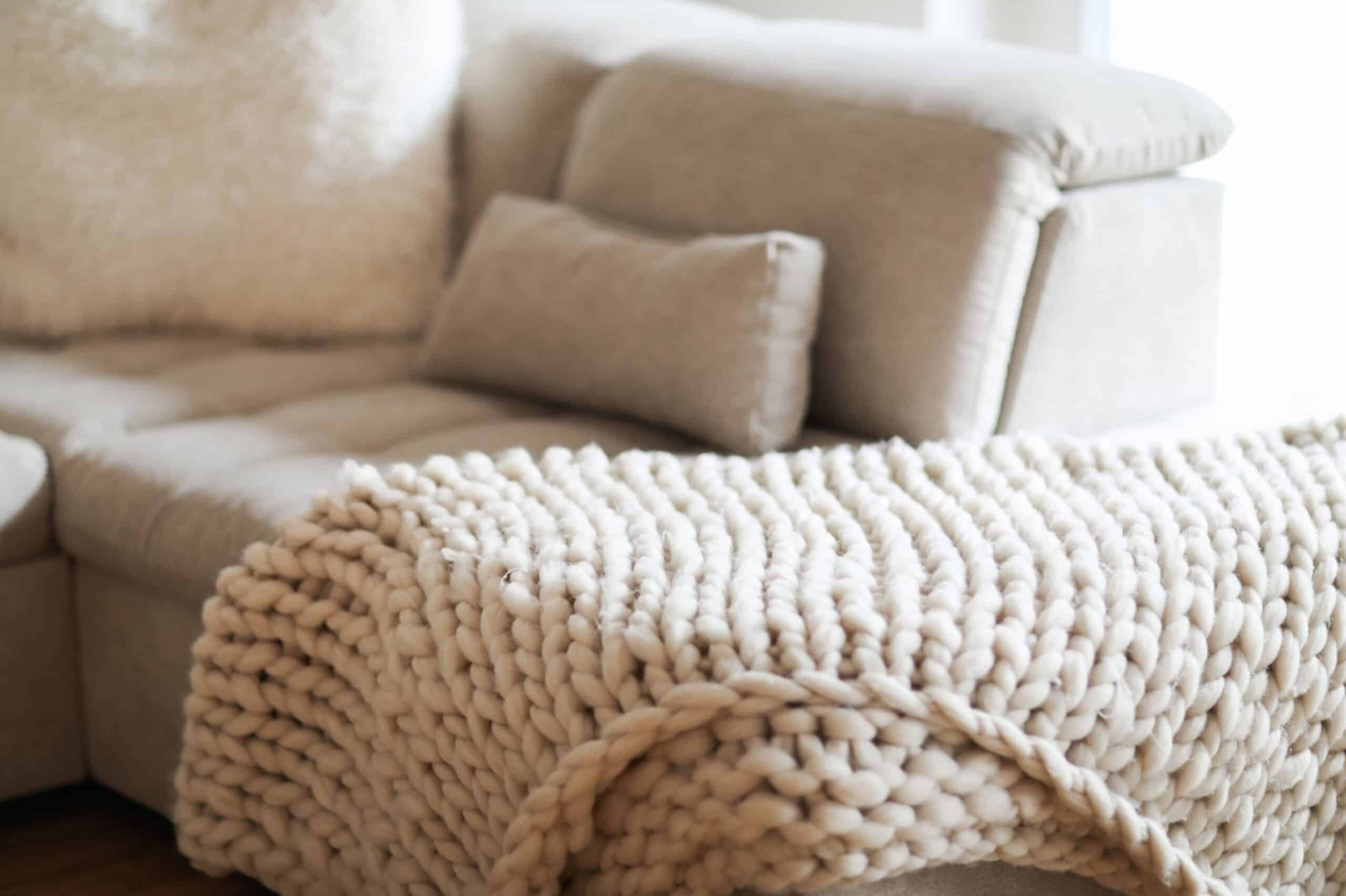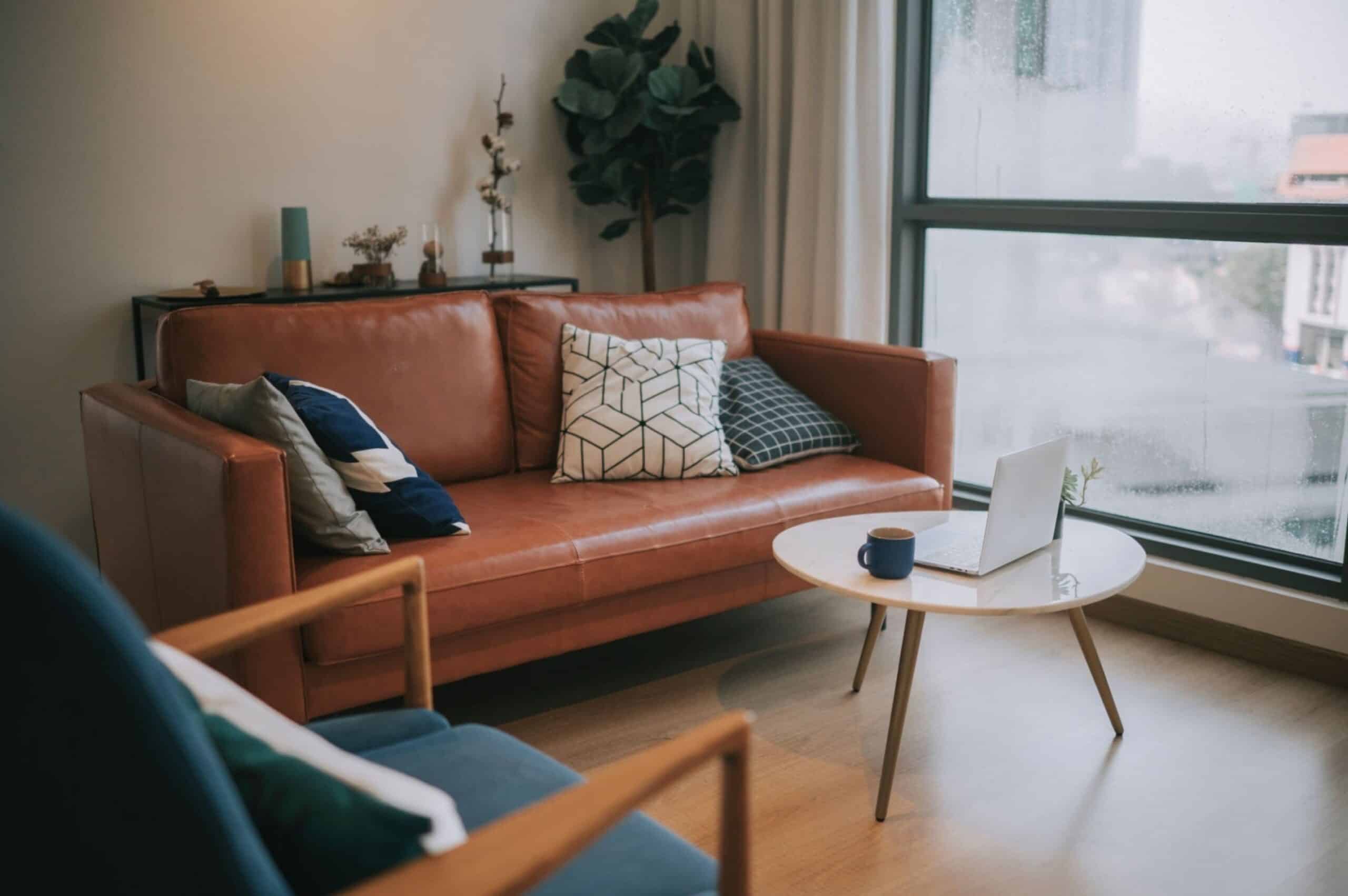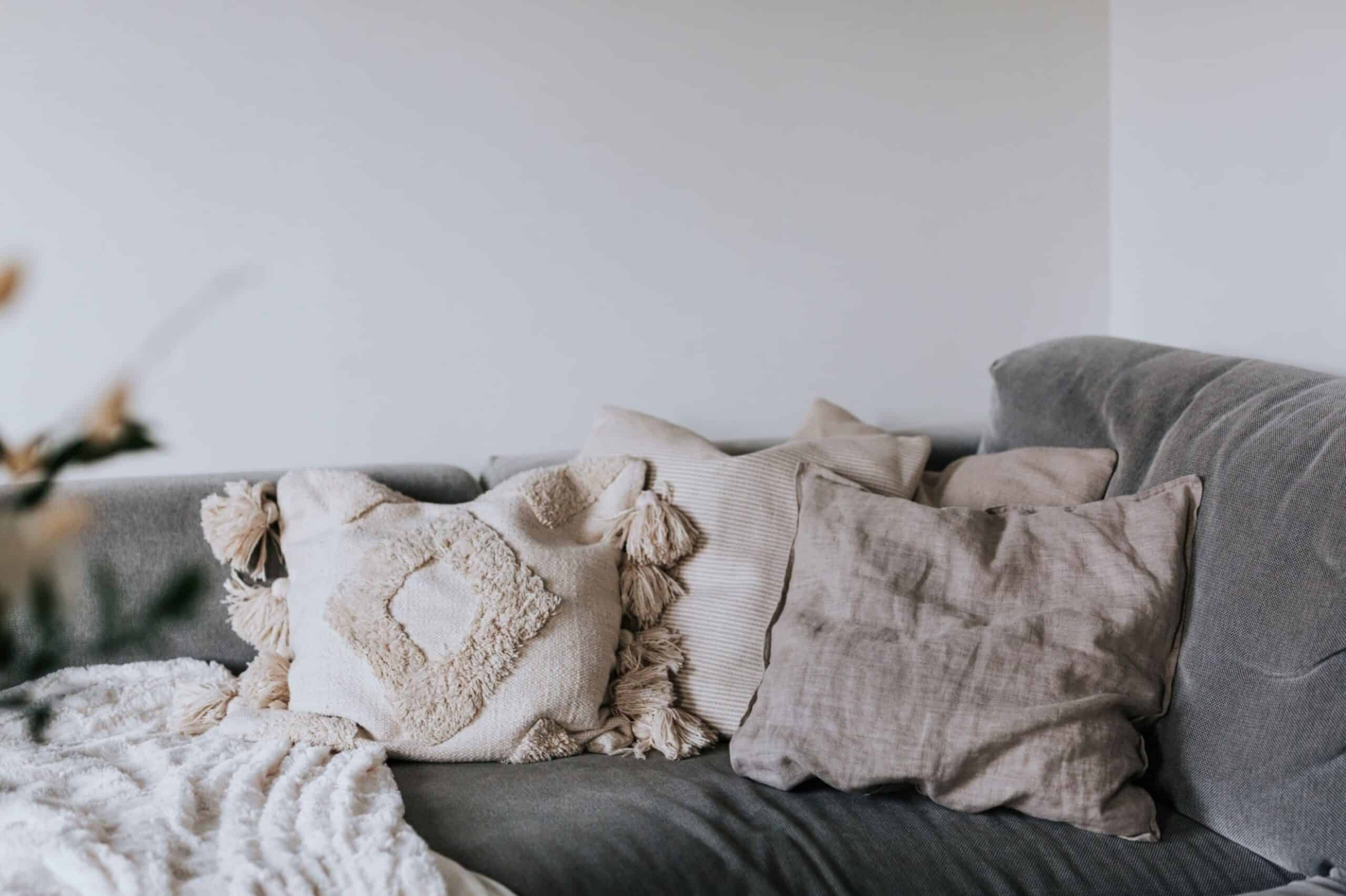We spend tons of time in our family rooms or living rooms, and almost too much time on our couches than we may care to admit. With all that time spent hanging out, watching movies, snacking, and playing on and around the couches, there’s bound to be some telltale wear and tear. There’s no shame in realizing your couch has seen better days, in fact it means that you made a solid investment in it as a piece of furniture.
But how do you save it from looking less than amazing when it sees so much regular use? When it comes to the care and upkeep of your beloved sofa, we’ve got you covered. Below, you’ll find our guide for cleaning the popular upholstery styles of couches and a few tips and tricks you can add to your regular cleaning routine. We hope you’ll find some helpful hints that will breathe new life into your family’s sofa.
Before You Clean
One of the most important pieces of information that we can share is this: Most fabric and upholstered furniture come with cleaning guidelines conveniently located on one tag. If you haven’t already found it, look around your couch and cushions for a tag that lists cleaning and upkeep information. On the tag, you should see a letter or series of letters, this is the cleaning code for the type of textile on your couch. Here are the meanings for each of the potential cleaning codes on the tag:
| W | This code indicates that water-based cleaners are recommended for cleaning your couch. |
| S | This code means that cleaning solvents are best for cleaning your couch. |
| WS | This means that both water based cleaners and solvents are safe to use when cleaning your couch. |
| X | If you see this code, it means that you should not use any water-based cleaners or solvents to clean you couch. You should only vacuum on this piece of furniture. |
Once you’ve located and read the information on the tag, you’ll know pretty much everything you need to know about the best way to clean and maintain your couch. If you’re still a little fuzzy about how to go about the cleaning process, check out the cleaning methods below or give us a call, we’re happy to help!
DIY Upholstery Cleaning
Now that you have a general idea of what to expect when cleaning your couch, we can get down the the nitty gritty. Below, you’ll find a few of the most common couch styles and how to properly clean them properly.
Fabric Couches
When cleaning a couch, always start by checking the cleaning code on the tag and then vacuuming the surface and under the cushions. It is recommended to use a stiff brush or dry towel to loosen any debris on the surface of the couch before vacuuming. Sprinkle a small amount of baking soda around the surface of the couch, and allow this to sit for about 20 minutes before vacuuming it up. This will help with deodorizing the fabric.
To clean the surface while the baking soda is on the couch, use the following DIY method:
- Mix ¼ cup of white vinegar, ¾ cup of war water, and 1 tablespoon of dish soap.
- You can choose to add a small amount of baking soda to the mix for a stain fighting boost.
- Pour this solution into a spray bottle and spray it onto a cloth, or directly onto any surface stains.
- Use the cleaner soaks cloth to rub the cleaner onto the surface of the couch to clean it. Make sure to apply the cleaner generously all over the surface to ensure a deeper clean.
- Allow the fabric to fully dry before replacing the cushions if they were removed and sitting on the couch.
Leather Couches
Cleaning leather couches can seem like a whole ordeal, but they can actually be some of the easiest couches to clean. To help break things down, here is how to properly clean a leather couch: As always, check the tag for the cleaning code and then vacuum the surface of the couch and under the cushions. Wipe the surface of the couch and cushions with a dry microfiber cloth, checking for stains as you wipe.
There are 3 options for cleaning your leather couch:
First, you can opt for a traditional leather cleaning solution that can be bought in most stores, just be sure to carefully and thoroughly read the directions on the product and check the cleaning code on the couch before using any solution.
Second, you can try this DIY leather cleaning solution:
- Combine equal parts water and white vinegar in a small bucket for surface cleaning.
- Dip a microfiber cloth in the solution and wring out the excess before wiping the solution around the surface of the couch and cushions.
- Use a fresh microfiber cloth to dry the surface of the couch and cushions thoroughly. Do not allow any excess solution to sit on the surface or you run the risk of water stains.
Third, if you need a boosted clean, you can try this DIY natural leather cleaner and conditioner:
- Mix ½ cup olive oil with ¼ cup vinegar in a spray bottle and spray the solution lightly around the surface.
- Use a dry microfiber cloth to buff the solution into the surface of the couch and cushions.
- Allow the couch to dry completely before replacing the cushions.
Once your couch has been cleaned and has time to dry, you can choose to apply a leather conditioner to keep it from cracking or fading. We suggest conditioning your leather couch at least twice each year.
Synthetic Couches
Cleaning couches with a synthetic fiber like polyester or microfiber is similar to regular fabric, but requires far less water or cleaner. Overuse of water or other cleaners on synthetic couches can damage the fibers, so follow the following guide for best practices:
- As with fabric, start by checking the cleaning code on the tag and vacuuming the surface of the couch free of loose debris.
- If you find that the couch is in need of some surface cleaning, remember to refer to the cleaning code for your solution.
- If the tag has an “X”, you should stick to just vacuuming the surface for now. We suggest using a soft bristle brush to dislodge and stubborn debris or stuck on residue before vacuuming the surface a second time.
- If the tag has an “S”, you can use a cleaning solvent to treat any surface stains. One of the most effective solvents for these couches is plain rubbing alcohol because of the quick evaporation rate.
- If the tag has “W” or “WS”, you can use water based solutions to clean the surface and treat stains. We suggest mixing together ½ cup of white vinegar, 1 cup of warm water and ½ tablespoon of liquid dish soap in a spray bottle and using this solution to clean the surface of the couch with a cloth or soft sponge.
- Once the couch has been cleaned or vacuumed, use a soft bristled brush to fluff out the fibers and allow the couch to fully dry if it has been cleaned.
Couch Cushions
If you have couch cushions with removable covers, the best way to clean these is by removing them and tossing them in the wash. Be sure to check the cleaning code on the tag before, however, so that you do not risk damaging the material. If you can remove the cushion covers and fid that there is deeper staining on the foam insert, you can usually treat these stains with a bit of white vinegar. Pour a few drops or spray a small amount of vinegar on the stain and use a cloth to blot the stain until it is removed.
Keeping Musty Odors at Bay
Between deep cleans, couches can develop a bit of a smell, you know the one. The smell usually develops quicker with kids, wet pets, and frequent couch eating. In order to combat the lingering odor from the surface of your couch, try this:
- Remove the cushions from the couch and set them aside to be treated separately.
- Vacuum the surface of the couch and the cushions and them sprinkle a generous amount of baking soda around both.
- Allow the baking soda to sit on the surface for up to an hour, depending on your preference and the odor level.
- Vacuum the surface of the couch and cushions thoroughly so that there is no trace of the baking soda.
- Check for any remaining odors and repeat the process if necessary. If not, you can replace the cushions and set the couch pillows as you like them
- We highly recommend topping off any odor treating with a little bit of Febreze or your go-to odor fighting fabric spray.
Extra Couch Cleaning Tips & Tricks
If you’ve gotten this far, we trust that your cleaning has been successful and now you’re in search of some extra care and upkeep tips. We have you covered, here are our best recommendations for keeping your couch looking good between deep cleans:
- If your couch has a water safe cleaning code on the tag and has a few deeply set stains, you can break out your steamer. By using a handheld steamer or an iron’s steam setting, you can loosen the fibers to treat set-in stains and even dislodge caked on food and other debris for a deeper clean.
- Some couches can be dust magnets, especially certain fabrics. If you’re between cleanings and want to make sure your couch is fresh for last minute company, try using a lint roller to de-fuzz and collect dust from the surface of your fabric couch.
- Handheld vacuums are often better at reaching into the tight spaces of the couch and between the cushions. Don’t be afraid to pull out your smaller vacuum for some more detailed cleaning and lint removal.
- When in doubt, don’t hesitate to call a professional. Asking for help when cleaning your upholstered furniture could mean the difference between saving the couch and having to buy a new one. Whoever said needing help was a bad thing? Save yourself stress and a headache by calling in a pro.
FAQ
How do you clean a fabric couch naturally?
You can create a natural fabric-safe cleaning solution by mixing together vinegar, warm water, baking soda, and a few drops of dish soap. This is a mild by effective solution that works great on most fabric couches, but remember to check for your couch’s cleaning code.
Can I use laundry detergent to clean my couch?
Laundry detergent can be used to clean upholstered couches when mixed and diluted with water. Be sure to check for any cleaning codes and test the mixture in a small and hidden area to make sure there is no staining or discoloration before using it to clean the entire couch.
Can I leave baking soda on my couch overnight?
You can safely leave baking soda on your couch overnight to absorb stubborn and lingering odors. Be sure to vacuum up the baking soda completely before replacing any cushions your removed or setting out any pillows.
How do you deodorize a fabric sofa?
You can easily deodorized a fabric sofa by sprinkling a small amount of baking soda around the surface or by using a odor fighting fabric spray like Febreze. Be sure to check for cleaning codes and vacuum any baking soda thoroughly.
How can I clean my couch without vinegar?
You can create a vinegar-free cleaning solution by mixing 1 cup of water, 2 teaspoons of baking soda, and 1 teaspoon of dish soap in a spray bottle. This solution is effective at stain treating and odor fighting due to the baking soda, but should be used in moderation. Remember to always check for cleaning codes on the couch’s tag.
If you’ve tried just about everything to keep your couch from looking and smelling like a hot mess and you’re this close to shopping for a new one, call us! We offer a range of residential cleaning services that could save you tons of time, money, and stress in the long-run.
Check out our website to browse our selection of services and read our blog posts for great cleaning and lifestyle tips. Be sure to contact us before you throw in the towel with your couch, you may be surprised at just how far a professional cleaning can go!
 Recurring Cleaning
Recurring Cleaning Move In / Out Cleaning
Move In / Out Cleaning Office Cleaning
Office Cleaning Housekeeping
Housekeeping Post Construction Cleaning
Post Construction Cleaning Green Cleaning
Green Cleaning Home Organization
Home Organization Deep Cleaning
Deep Cleaning Oven Cleaning
Oven Cleaning Airbnb Cleaning
Airbnb Cleaning Refrigerator Cleaning
Refrigerator Cleaning





